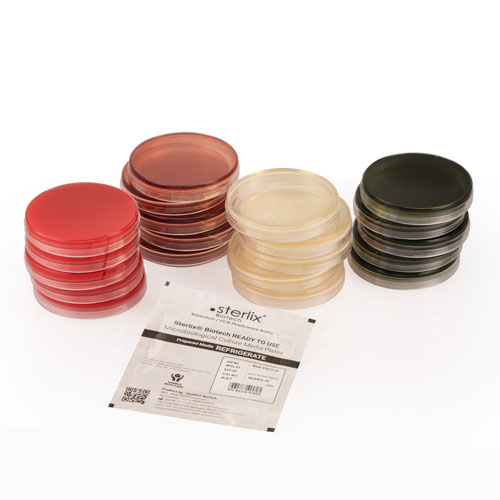STERLIX® TCBS Ready To Use Agar Plate
Product Details
TCBS agar (Thiosulfate Citrate Bile Salt Sucrose agar) is a selective and differential culture medium primarily used for the isolation and identification of Vibrio species, particularly Vibrio cholerae and other pathogenic Vibrio species. It is commonly employed in the diagnosis of cholera and other vibriosis infections.
The composition of TCBS agar typically includes the following components:
Thiosulfate: Thiosulfate serves as a sulfur source, promoting the growth of Vibrio species.
Citrate: Citrate acts as a pH buffer, maintaining the optimal pH range for Vibrio growth.
Bile salts: Bile salts, such as sodium cholate or sodium deoxycholate, inhibit the growth of gram-positive bacteria, allowing for the selective isolation of Vibrio species.
Sucrose: Sucrose is a fermentable carbohydrate that differentiates between sucrose-fermenting and non-fermenting bacteria.
Sodium thiosulfate: Sodium thiosulfate acts as a reducing agent, creating a low oxygen tension environment that favors the growth of Vibrio species.
Bromothymol blue: Bromothymol blue is a pH indicator that turns the agar yellow when acid is produced due to sucrose fermentation.
Agar: Agar is added as a solidifying agent to provide a solid surface for bacterial growth.
TCBS agar is primarily used for the isolation and identification of Vibrio species, particularly Vibrio cholerae, which causes cholera. The selective components in TCBS agar inhibit the growth of other bacteria while allowing the growth of Vibrio species. The differential component, sucrose, helps differentiate between sucrose-fermenting Vibrio species (yellow colonies) and non-fermenting species (green colonies).
On TCBS agar, typical characteristics of Vibrio species include:
Vibrio cholerae: Vibrio cholerae forms yellow colonies on TCBS agar due to sucrose fermentation. These colonies may also exhibit a flat, mucoid appearance.
Non-cholera Vibrio species: Other pathogenic Vibrio species, such as Vibrio parahaemolyticus or Vibrio vulnificus, may also produce yellow colonies on TCBS agar.
Non-fermenting bacteria: Non-fermenting bacteria, including many other enteric organisms, typically form green colonies or colonies that do not change color on TCBS agar.
It is important to note that while TCBS agar is commonly used for the isolation and identification of Vibrio species, additional confirmatory tests, such as biochemical tests and serological methods, are typically required for accurate identification and differentiation of Vibrio species.
Proper handling, storage, and incubation conditions are essential when using TCBS agar to ensure optimal results and accurate identification of Vibrio species. It is advisable to follow established laboratory protocols and manufacturer instructions for the preparation and utilization of TCBS agar plates.
The composition of TCBS agar typically includes the following components:
Thiosulfate: Thiosulfate serves as a sulfur source, promoting the growth of Vibrio species.
Citrate: Citrate acts as a pH buffer, maintaining the optimal pH range for Vibrio growth.
Bile salts: Bile salts, such as sodium cholate or sodium deoxycholate, inhibit the growth of gram-positive bacteria, allowing for the selective isolation of Vibrio species.
Sucrose: Sucrose is a fermentable carbohydrate that differentiates between sucrose-fermenting and non-fermenting bacteria.
Sodium thiosulfate: Sodium thiosulfate acts as a reducing agent, creating a low oxygen tension environment that favors the growth of Vibrio species.
Bromothymol blue: Bromothymol blue is a pH indicator that turns the agar yellow when acid is produced due to sucrose fermentation.
Agar: Agar is added as a solidifying agent to provide a solid surface for bacterial growth.
TCBS agar is primarily used for the isolation and identification of Vibrio species, particularly Vibrio cholerae, which causes cholera. The selective components in TCBS agar inhibit the growth of other bacteria while allowing the growth of Vibrio species. The differential component, sucrose, helps differentiate between sucrose-fermenting Vibrio species (yellow colonies) and non-fermenting species (green colonies).
On TCBS agar, typical characteristics of Vibrio species include:
Vibrio cholerae: Vibrio cholerae forms yellow colonies on TCBS agar due to sucrose fermentation. These colonies may also exhibit a flat, mucoid appearance.
Non-cholera Vibrio species: Other pathogenic Vibrio species, such as Vibrio parahaemolyticus or Vibrio vulnificus, may also produce yellow colonies on TCBS agar.
Non-fermenting bacteria: Non-fermenting bacteria, including many other enteric organisms, typically form green colonies or colonies that do not change color on TCBS agar.
It is important to note that while TCBS agar is commonly used for the isolation and identification of Vibrio species, additional confirmatory tests, such as biochemical tests and serological methods, are typically required for accurate identification and differentiation of Vibrio species.
Proper handling, storage, and incubation conditions are essential when using TCBS agar to ensure optimal results and accurate identification of Vibrio species. It is advisable to follow established laboratory protocols and manufacturer instructions for the preparation and utilization of TCBS agar plates.

